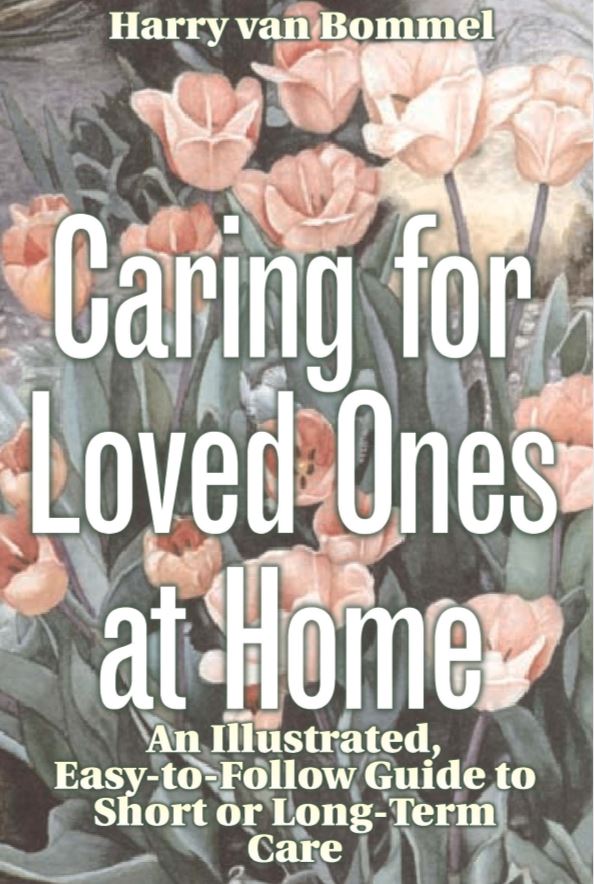The greatest invention in the world (or so it seemed to me at the time I was taking care of my parents) is a draw sheet. This is just a regular sheet folded several times and placed side-ways on the bed. The person lies on top with the sheet under their shoulders and hips. A person on either side of the bed grabs the sheet at the same time and together they lift the person up to move them closer to the head or the bottom of the bed. This is very helpful when someone is sitting up in bed and they keep sliding to the foot of the bed. If they cannot move themselves, the draw sheet is perfect to move them without a lot of pulling or pushing on their skin. You can also use the draw sheet to help turn someone onto their side by placing one end of the draw sheet over the person and pulling it towards you.
Helping Turn Someone in Bed
Other than the draw sheet, you can also help a person turn in bed in the following way:
Have their far arm across their chest towards you.
Bend their far leg at the knee while their foot still rests on the mattress.
Bring the bent leg towards you. As you do this, their far shoulder will naturally start to move towards you through the leverage of the leg.
Reach over with your hand to guide their shoulder towards you comfortably and safely. This will put the person on their side with their bent knee giving extra security.
Place pillows to support their back and, if necessary, between their legs for added comfort.
Adjust the head pillow as needed.
Getting Someone Out of Bed and Into a Chair
Get a physiotherapist, occupational therapist or nurse to show you the proper techniques for your specific situation. Also ask them about transfer and walking belts that can give you something to hold onto when helping the person move about. Remember, what you do for someone who is weak from surgery is not the same as what you might do for someone who has partial paralysis.
The following are some general tips that can help you remember what you have been shown by a professional.
1. Put a safe and solid chair with arm rests next to the bed facing you. The chair should be high enough to make it easy for the person to get into it and out again.
2. Raise the head of the bed as high as it will go. Help move the person’s legs over the side of the bed. If the bed is not adjustable, have them lay on their side, move their legs over the side of the bed and slip your closest hand under their neck and shoulder to support those parts as they lift up. Give them a moment to rest, as they may be a bit dizzy after lying down so long.
3. Help put the person’s slippers or shoes on (or do it when they are still lying down if they cannot help).
4. If the bed is too high put a strong footrest by the bed to help the person step down comfortably.
5. Help the person slide forward to the edge of the bed so their feet are touching the floor or footstool.
6. Face the person with your foot that is nearest the chair one step behind the other. This will allow you to turn easily in the direction of the chair. Have the person put their hands on their knees to help them push up with their legs. Guide them with your hands around and under their buttocks and assist the person to stand on their own feet. If they need extra support, hold them under their elbows as they hold your upper arms and lift together. If necessary, use two people to provide the support needed to lift the person and transfer them to a chair safely.
7. Have the person brace themselves with their hands around your elbows while you hold them under their elbows for leverage.
8. Help the person slide off the bed.
9. Bend your knees and press your forward knee against the person’s opposite knee. Let them catch their breath and balance themselves as they stand.
10. Let the person shuffle backward towards the chair if they can and help them lower themselves. If they need help, pivot them using the pressure on their knee, and then lower them into the chair.
From a Chair into Bed
Reverse the instructions from above making sure the person helps with as much of the moving as possible. As well, make sure the chair, footstool and bed won’t move while you are helping the person. using their right leg to pivot on, use your left hand to help them turn. Once in the chair, let them sit down for a more comfortable rest. If they cannot get up, wait for help to bring them back to bed or try to slide the chair to the bed. At all times, remember to safeguard your own back since you cannot be helpful if you injure yourself.
If the person is too weak to use both hands to push themselves up from the ground, have them use one hand on the chair and you use your strongest forearm under their remaining bent forearm. As they lift up from the ground using their bent pivot leg, you lift with your arm at the same time with your other arm providing support at their belt or around their waist.
Caring For Loved Ones At Home – Free eBook – click here.
Click here for Harry’s previous article on Helping People Get Around.
This article is intended for informational purposes only. If you have any questions or are considering any recommendations, please consult your health practitioner.























